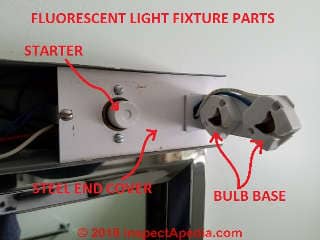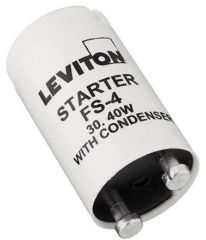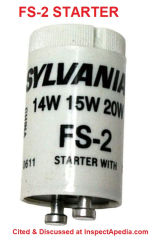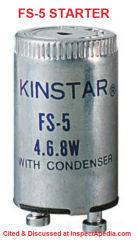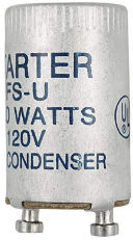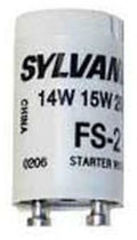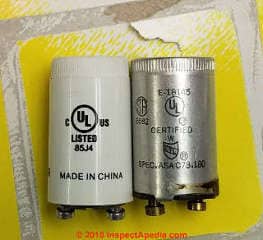 Fluorescent Light Starter Replacement
Fluorescent Light Starter Replacement
Replace the starter if the fluorescent light won't ignite
- POST a QUESTION or COMMENT about building electrical systems, power, wiring, and flickering or dimming lights
Steps in diagnosing and repairing a flickering fluorescent light:
When one or more fluorescent light fixtures are humming or flickering or if the light simply won't turn on, the problem may be something as simple as a bad fluorescent bulb.
But there are other causes of flickering lights: some are also trivially easy to repair while others require more expertise and cost. Here we sort out the causes and cures for flickering fluorescent lights, and we give details for wiring connections when replacing the ballast or transformer for the fluorescent light fixture shown.
This article series explains how to diagnose the causes of flickering or dimming lights at or in buildings.
Watch out: flickering or dimming lights might indicate a dangerous condition risking a building fire or an electrical shock. If the simple bulb or starter repairs we describe here don't cure the flickering, switch off the bad-acting light fixture, leave it off, circuit and ask for help from a licensed electrician.
InspectAPedia tolerates no conflicts of interest. We have no relationship with advertisers, products, or services discussed at this website.
- Daniel Friedman, Publisher/Editor/Author - See WHO ARE WE?
Replacing a Bad Fluorescent Light Starter
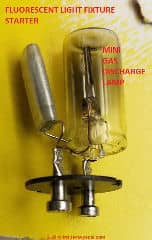 What is the Function of the Fluorescent Lamp Starter & How Does it Work?
What is the Function of the Fluorescent Lamp Starter & How Does it Work?
The fluorescent lamp starter is a simple switch activated when the light fixture is first turned-on.
[Click to enlarge any image]
The starter is essentially a tiny switch whose contacts,heated by current flowing through it when first turned-on, sends high current through the main tube filaments to initiate the ionization of the mercury vapor in the lamp.
The switch heats and closes briefly when power is applied - that is, when the lamp is first switched on - to start the gas ionizing process. Then as the starter's internal arc and lamp heat up, one of the contacts, a bi-metallic strip, bends to open the switch.
When the starter's internal switch opens that causes a collapse of the magnetic field in the ballast.
When the ballast's magnetic field collapses it induces a large current at high voltage that is fed to the electrodes in the fluorescent tube itself, providing the initial voltage needed to start an electrical current (a gas plasma) flowing through the tube, creating a passage through which current then continues to flow, exciting the gases in the tube and causing it in turn to excite the phosphorescent coating in the tub, causing, then, the emission of visible light.
The starter switch remains off until the next time the fluorescent light fixture is turned-on. This basic design has been improved in modern fluorescent fixtures to create a rapid-start or nearly-instantantaneously-starting fluorescent light tube.
Our photo below shows where you can find the starter for your light fixture - if one is present at all. You'll see the round canister located behind and near one end of the light fixtures.
Really? Well not always. Depending on the ballast type and design, your fluorescent light may not use a starter at all, so don't be stymied if you cannot find the part.
The following and nicely-detailed explanation of exactly what's going on in the traditional fluorescent lamp starter is adapted from Vitanza (1999).
The starter triggers the tube when it is first turned on. It consists of two contact strips, one normal and one bimetallic, which are normally open, enclosed in a glass envelope filled with inert gas.
When mains is applied to the circuit, the voltage is not sufficient to cause spontaneous ionisation of the gas in the main tube, and the lamp remains in a high impedance state (i.e. not turned on).
However, the electric field which the mains creates in the small gap between the contacts in the starter is sufficient to ionise the gas there. This allows a current to flow in the metal strips and through the gas (and also through the filaments of the main tube, which heats them and facilitates the subsequent ionisation).
The heat generated by the current flow through the gas causes the bimetallic strip to bend towards the other.
When the contacts finally touch, two things occur: firstly the gas in the starter de-ionises, and so the bimetallic strip begins to cool.
Secondly, as the impedance of the circuit falls, the current through the ballast inductor and the filaments of the main tube increases.
A few tenths of a second later, the bimetallic strip has cooled sufficiently to bend back slightly, reopening the gap.
The sudden increase in impedance and consequent sharp reduction in inductor current causes a large overvoltage across the inductor.
Given the correct conditions ... this overvoltage is large enough to cause ionisation of the gas in the main tube.
At this point the impedance of the fluorescent tube falls to a minimum, and the voltage drop across it falls to a level below that required to ionise the gas in the starter contact gap. The contacts thus remain open until the lamp is next turned on. -Vitanza 1999 cited in detail
at FLUORESCENT LAMP INSTRUCTIONS, PARTS, REPLACEMENTS .
Replace a Fluorescent Lamp Starter
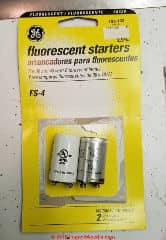 When repairing a flickering fluorescent light by replacing a ballast or by repairing damaged wiring, it makes sense to also install a new starter. The starter is very inexpensive.
When repairing a flickering fluorescent light by replacing a ballast or by repairing damaged wiring, it makes sense to also install a new starter. The starter is very inexpensive.
Our photo shows a new white GE FS-4 fluorescent starter in the original package with an older silver FS-4 next to it for comparison. The white GE FS-4 starter was so fragile as to be useless - it could not be safely installed, as I explain below.
To remove the old starter you need simply to
- Press down slightly on the starter
- Rotate the unit about 45 degrees in its socket: the pins will move to a slot that lets you
- Remove the starter from its base.
To install a new starter,
- Select the right starter for your fluorescent light fixture - see the FS- starter guide we give below in table form. Usually you will simply match the number of the old starter, or use an FS-U universal replacement starter.
- Press the starter down into the base, aligning its pins with the entry openings in the base, then
- Rotate it 45 degrees to click into place.
Epidemic of Poorly-Made Fluorescent Bulb Starters that Disintegrate During Installation
Watch out: however the brand new GE - General Electric - brand starter disintegrated under even the most-gentle rotating force of inserting it into the starter socket (which requires twisting the starter into place).
The current GE-brand fluorescent light starter, made in China, was so flimsy as to be completely worthless (in my opinion).
The force needed to rotate the starter to lock into its base was more than the force that would cause the starter cap to separate from the starter base - held in place by mere compression nubs on the white GE starter case.
Ultimately I got the light working again by re-installing the original starter that was made far more durably.
Above I show the two devices side-by-side. The new white GE fixture made in China is at left. The decades old and still-working starter is the silver can shown at right in the photos.
My photo below shows how the base of the GE starter simply popped out of the white canister during installation - an unsafe condition.
This GE fluorescent light fixture starter was a disappointment that went into the trash. I re-installed the old one that actually was working fine.
Fluorescent Bulb / Light Fixture Starter Replacement Size Guide
Below is a table giving common fluorescent bulb or lamp wattages and FS- automatic starter values.
Fluorescent Bulb Starter Replacement Guide |
|||
| Starter Code | Lamp Wattage | Lamp Size | Lamp Shape |
| FS-U Starter (Universal) | 4 W to 30 W | Various | Various |
| FS-2 Starter 1 | 14W, 15W, 20W | 15", 18", 24" | Straight |
| FS-4 Starter | 13W, 30W, 40W | 12", 36", 48" | Straight |
| FS-5 Starter | 4W, 6W, 8W | 6", 8", 12" | Straight, T12 |
| FS-12 Starter | 32W, 40W | 12", 16" | Straight |
| FS-20 Starter | 14W, 15W, 20W, 25W 2 | 15", 18", 24" | Straight |
| FS-25 Starter | 20W linear T9, 20W & 22W Circline, 25W linear | Straight or Circline | |
Notes to the table above
- Some FS-2 starters such as from Philips may be illustrated online using an FS-4X photo (at Home Depot) ? Be sure to check the specifications in Watts marked on the starter itself.
- Some FS-20 starters can also be used with 25W straight fluorescent bulbs: check the manufacturer's specifications.
- Starter operating tip - reverse the starter: if you install a new fluorescent bulb starter and the lamp still isn't working well, or not lighting at all, try removing the starter, rotating it 180 degrees and re-installing it, essentially "reversing" its position in the starter socket.
If that still doesn't give good results be sure the bulb is good, then check the bulb's position in the mounting clips to be sure it's making good electrical contact.
Watch out: there are many manufacturers and suppliers of fluorescent lamp starters in the FS- series. Some of these, possibly made in China, are in our experience and opinion poorly made and may fall apart during installation, as we illustrate above on this page.
Shown below: An FS-4 Starter provided by Leviton.
Sources & Technical Support for Fluorescent Lamp Starters, Ballast Capacitors, Igniters
- 1000bulbs.com 2140 Merritt Dr, Garland, TX 75041 USA Website: https://www.1000bulbs.com/ Tel: 1-972-525-0501
- Amazon.conm - search for Fluorescent lamp starters
- Building suppliers such as Home Depot, Lowes, Menards
- Local hardware stores near you such as Ace® hardware.
- Local electrical suppliers near you
- Petco: starters for lights used in aquariums
- Replacementlightbulbs.com 800 Burton Avenue, Suite 107 High Point, NC 27262 336-882-BULB (2852) Order Line: 800-692-3051 Technical Support Line: 336-882-2854 Technical support email: support@replacementlightbulbs.com Website: Replacementlightbulbs.com
- Superior Lighting, 3530 NW 53rd St Fort Lauderdale, FL 33309 USA, Tel: 1-888-351-7048 Website: https://www.superiorlighting.com/
- Zoro Tools Inc., Tel: (855) 289-9676 Website: zoro.com [actual physical address not found - Why?]
InspectAPedia is an independent publisher of building, environmental, and forensic inspection, diagnosis, and repair information for the public - we have no business nor financial connection with any manufacturer or service provider discussed at our website.
...
Reader Comments, Questions & Answers About The Article Above
Below you will find questions and answers previously posted on this page at its page bottom reader comment box.
Reader Q&A - also see RECOMMENDED ARTICLES & FAQs
Question: what's the difference between a GE FS-2 and a GE FS-5 fluorescent starter?
2021/06/27 Daniel J Tomas
what is the difference between a GE FS-5 and a GE FS-2 fluorescent starter?
Moderator reply:
Thanks that's a helpful question.
A GE FS-5 or Sylvania FS-5 or equivalent is a fluorescent light fixture "ballast starter" or "fluorescent lamp starter" that can handle a total / maximum bulb wattage of 8 watts.
A GE FS-2 or Sylvania FS-2 or equivalent is a starter that can handle a total / maximum bulb wattage of 20 watts.
You want to match the wattage of the fluorescent starter device to the wattage of the bulbs in the fixture.
Really?
Well it's ok to use a higher-wattage capacity starter like an FS-2 on a lower-wattage bulb fixture, but not the reverse.
Take a look at the table in the article above titled
Fluorescent Bulb Starter Replacement Guide
Question: difference between an FS-20 and an FS-U fluorescent lamp starter
2020/04/13 Susan said:
I'm trying to replace a ballast starter.
Is there a difference between a FS-20 and a FS-U ? My part is a FS-U and I can't find one.
Shown here: An FS-U Universal starter and a Sylvania FS-20 starter for fluorescent lamps.
Reply:
Thank you for asking about FS-U starters for fluorescent lights, Susan as it tells me where we need to be more clear.
- The FSU (Universal) - Fluorescent Starter is a "universal" starter replacement that can handle fluorescent lamps anywhere in size 4 W to 30 Watts.
- An FS-20 fluorescent starter is rated for use with F14, F15, and F20 "preheat" fluorescent lamps or bulbs.
FSU starters are widely sold in electrical supply stores, building supply stores, and even from online vendors.
However if you have a failed FS-U starter and happen to have an FS-20 on hand, you can use the FS-20 as long as the fluorescent bulb or lamp is 20W or less.
The FSU ballast starter shown below is available from Amazon and is distributed by Normal Lamps. ($4.00 U.S.)
...
Continue reading at FLUORESCENT LIGHT TRANSFORMER / BALLAST REPLACEMENT or select a topic from the closely-related articles below, or see the complete ARTICLE INDEX.
Or see these
Recommended Articles
- DIRECTORY OF ELECTRICIANS
- ELECTRIC POWER LOSS / FLICKERING LIGHTS
- FLUORESCENT LIGHTING GUIDE INDOORS for Indoors and Guide to Using Compact Fluorescent Lights
- FLUORESCENT LIGHTS COMPACT INDOOR
- FLUORESCENT LIGHT REPAIRS
- HOW FLUORESCENT LIGHTS WORK
- ELECTRIC POWER LOSS / FLICKERING LIGHTS
- DIAGNOSE a BAD FLUORESCENT LAMP / BULB
- LED BULB REPLACES FLUORESCENT
- REPLACE a FLUORESCENT LAMP / BULB
- FLUORESCENT LIGHT BALLAST TYPES
- FLUORESCENT LIGHT BULB CODES & TYPES
- FLUORESCENT LIGHT BULB PHOTOS
- FLUORESCENT LIGHT BULB COLOR TEMPERATURE
- FLUORESCENT LIGHT FLICKERING CAUSES
- FLUORESCENT LIGHT STARTER REPLACEMENT
- FLUORESCENT LIGHT TRANSFORMER / BALLAST REPLACEMENT
- FLUORESCENT LIGHT TRANSFORMER / BALLAST TYPES
- FLUORESENT BULB SOCKET TYPES
- FLUORESCENT LAMP CONNECTOR / SOCKET REPLACEMENT
- FLUORESCENT LIGHT FIXTURE BULB / BALLAST DISPOSAL
- FLUORESCENT LAMP INSTRUCTIONS, PARTS, REPLACEMENTS
- FLUORESCENT vs INCANDESCENT BULBS
Suggested citation for this web page
FLUORESCENT LIGHT STARTER REPLACEMENT at InspectApedia.com - online encyclopedia of building & environmental inspection, testing, diagnosis, repair, & problem prevention advice.
Or see this
INDEX to RELATED ARTICLES: ARTICLE INDEX to ELECTRICAL INSPECTION & TESTING
Or use the SEARCH BOX found below to Ask a Question or Search InspectApedia
Ask a Question or Search InspectApedia
Try the search box just below, or if you prefer, post a question or comment in the Comments box below and we will respond promptly.
Search the InspectApedia website
Note: appearance of your Comment below may be delayed: if your comment contains an image, photograph, web link, or text that looks to the software as if it might be a web link, your posting will appear after it has been approved by a moderator. Apologies for the delay.
Only one image can be added per comment but you can post as many comments, and therefore images, as you like.
You will not receive a notification when a response to your question has been posted.
Please bookmark this page to make it easy for you to check back for our response.
IF above you see "Comment Form is loading comments..." then COMMENT BOX - countable.ca / bawkbox.com IS NOT WORKING.
In any case you are welcome to send an email directly to us at InspectApedia.com at editor@inspectApedia.com
We'll reply to you directly. Please help us help you by noting, in your email, the URL of the InspectApedia page where you wanted to comment.
Citations & References
In addition to any citations in the article above, a full list is available on request.
- Our recommended books about building & mechanical systems design, inspection, problem diagnosis, and repair, and about indoor environment and IAQ testing, diagnosis, and cleanup are at the InspectAPedia Bookstore. Also see our Book Reviews - InspectAPedia.
- In addition to citations & references found in this article, see the research citations given at the end of the related articles found at our suggested
CONTINUE READING or RECOMMENDED ARTICLES.
- Carson, Dunlop & Associates Ltd., 120 Carlton Street Suite 407, Toronto ON M5A 4K2. Tel: (416) 964-9415 1-800-268-7070 Email: info@carsondunlop.com. Alan Carson is a past president of ASHI, the American Society of Home Inspectors.
Thanks to Alan Carson and Bob Dunlop, for permission for InspectAPedia to use text excerpts from The HOME REFERENCE BOOK - the Encyclopedia of Homes and to use illustrations from The ILLUSTRATED HOME .
Carson Dunlop Associates provides extensive home inspection education and report writing material. In gratitude we provide links to tsome Carson Dunlop Associates products and services.


